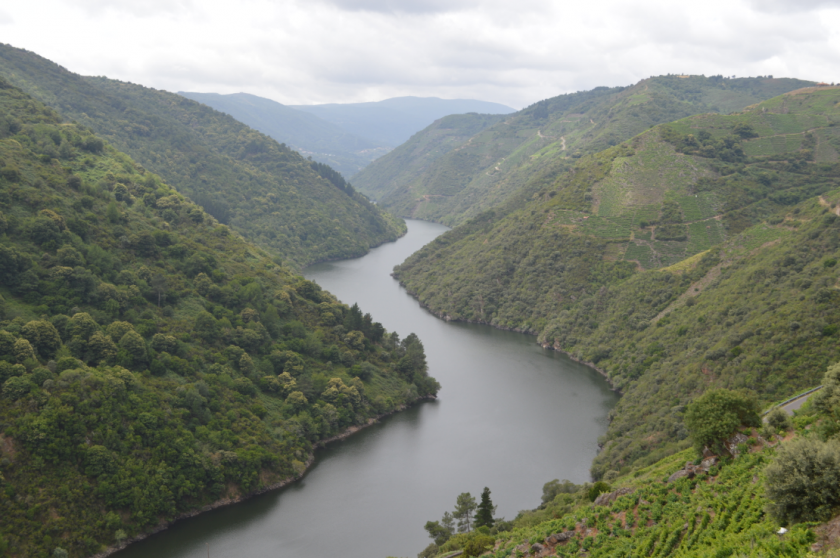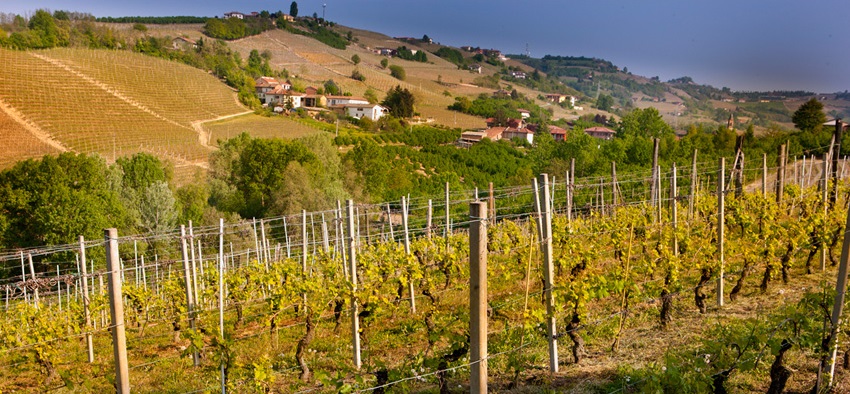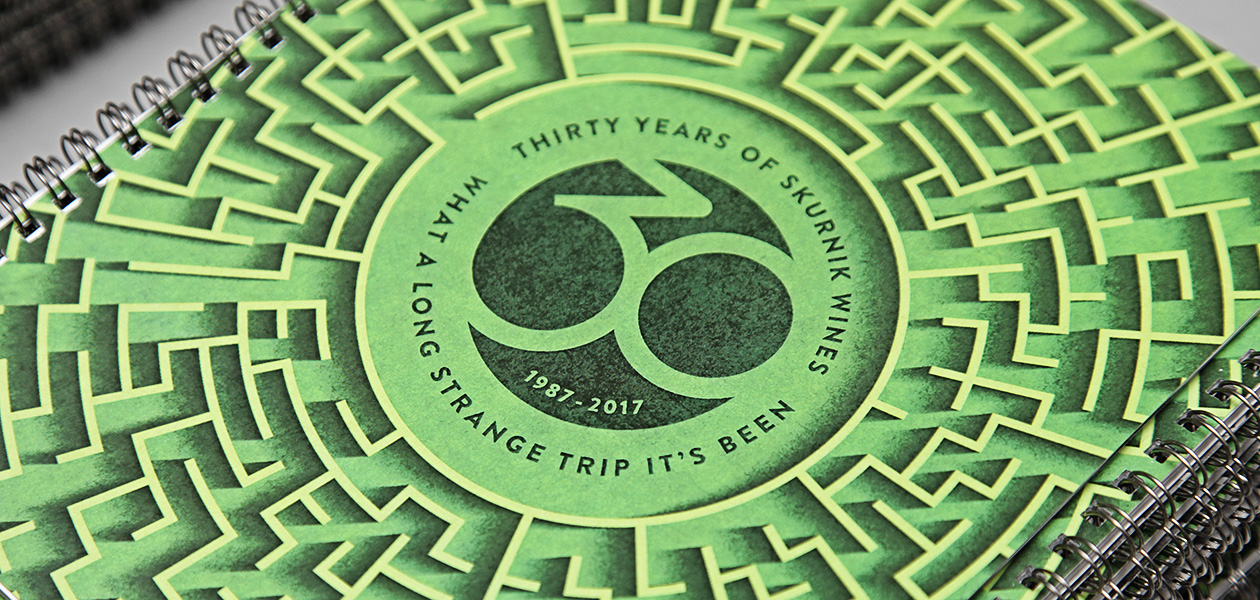
It is our distinct pleasure to announce that Skurnik Wines will now be the exclusive national importer for Bodegas y Viñedos Raúl Pérez, La Vizcaína de Vinos and Castro Candaz. Raúl has long been a “friend of the house” and we are very excited to expand our partnership with him to cover the entire nation. We admire Raúl as much for his humility, candor and generosity of spirit as we do for his otherworldly wines, and we are tremendously honored that we and our national partners will enjoy the privilege of helping to broaden the ranks of wine lovers who have been touched by his singular gift.
Read more about Raúl and his wines below and don’t hesitate to call your sales rep with any questions. We expect the wines to be available for sale by the beginning of March. Prices available upon request.
• • • • •
“This car is kind of like my closet,” Raúl says, as he digs through the back of his beat-up old Mercedes G-Wagon for a pair of tennis shoes. Having swapped his boots for a fresh pair of Adidas, he courteously removes the rifle from the passenger seat to make room for me and nonchalantly tosses it in the back. As I climb up into what is quite literally the shotgun seat, I ask if he’s been out hunting. “No,” he says, “I’m not much of a hunter. This is more about a personal war with the rabbits.” He flashes me a you-know-how-it-is look and we take off for our first cellar visit.
One of Raúl’s two facilities in Bierzo is a small, naturally-cooled cellar in a centuries-old stone building in the village of Salas de los Barrios (pop. 72 as of the 2014 census). We taste from a number of barrels as he explains the main differences between the wines produced from the slate-based soils of the Ponferrada zone and those of the sand- and clay-rich Valtuille zone. Though Raúl can give off a shambolic vibe when it comes to things like fixed meeting times and locations, he knows exactly what is going on down to the microbial level in each and every one of his barrels at any given time. The winemaking process can differ slightly from wine to wine, but the general idea for the Bierzo reds is macerations of 50-90 days (Raúl calls 50 days a “short” maceration), whole cluster fermentations in large foudres and racking to used 300L-500L barrels for maturation.
Depending on the particular region (and often on the person you are talking to), the grape is known variously as Bastardo, María Ordoñez, Domingo Pérez, Merenzao, Godello Tinto and Verdejo Negro, but ampelographic studies have shown it to be genetically identical to the Trousseau found predominately in the Jura region of France.
In addition to the wines released under the Bodegas y Viñedos Raúl Pérez label, there is also a relatively new set of wines that correspond to single parcels in the village of Vatuille de Abajo. Four reds and one white are produced under the name La Vizcaína de Vinos, all from vines with over sixty-five years of average age. Though all the red wines Raúl produces in the Bierzo D.O. are composed predominately of Mencía, they all in fact contain significant quantities of other local grapes. The rich varietal diversity found in Galicia is due in large part to the famous Camino de Santiago, a pilgrimage to the tomb of Saint James in the town of Santiago de Compostela, the earliest references to which date back to the 9th century. The monks who made the journey would often carry vine cuttings from their home regions in their packs to offer as gifts to the Spanish monasteries that would put them up along the way. This is certainly the explanation for the preponderance of Trousseau found throughout northwestern Spain. Depending on the particular region (and often on the person you are talking to), the grape is known variously as Bastardo, María Ordoñez, Domingo Pérez, Merenzao, Estaladiña, Godello Tinto and Verdejo Negro, but ampelographic studies have shown it to be genetically identical to the Trousseau found predominately in the Jura region of France. Other red varieties found scattered around the old vineyards of Bierzo include Sousón, Alicante Bouschet, Brancellao and Caiño. Curiously, Mencía and Alicante Bouschet are the only varieties approved by the D.O., hence the practice of simply labeling the wines as Mencía.
As we are walking back out of the cellar, Raúl takes a moment to point out a foudre that stands empty. “That’s where I found her,” he says solemnly, referring to his niece, Nerea Pérez, who was overcome by gaseous emissions from a fermenting wine, rendering her unconscious and causing her to fall into the vat and drown in September of 2014. She was 25 years old. “A lot of memories in this bodega, not all of them good,” he says. “We’re never going to fill that vat again, but I also don’t want to move it. I’ve thought about selling it but, if the soul exists, and some part of hers is still in there…how could I do that to someone I love?” Nerea’s death was not the first tragedy to visit the Pérez family. Raúl’s father died of carbon monoxide inhalation while cleaning a cement tank of its leftover lees, as did the winery worker who jumped in to save him. “Maybe we’re cursed,” he says as he drives us out of town, waving to a clutch of elderly women seated on folding chairs in the plaza.
• • • • •
After lunch at Raúl’s mother’s house in the village of Valtuille de Abajo, we exchange the Mercedes tank for a sexed-up MINI Cooper and head east in the direction of León. The next bodega we visit is in a remote area that corresponds to the Tierra de León D.O. where Raúl is working on experiments with the Prieto Picudo and Albarín grapes. Unlike Bierzo, which is all about wine, this area is more prized for hops than for grapes. The bodega is a little bit of a mess. It’s housed in a dilapidated farmhouse with a very old stone shell that clashes somewhat jarringly with a more recent, utilitarian-looking addition. There is a pool in the courtyard, empty but for a half meter of sludge at the bottom. Raúl searches for a key behind a loose stone in the facade, saying, “Now you’ll know how to get in if you’re in the area and need a place to crash.” Noted.
“The idea here is to beat the heck out of the wines. We can then figure out what they can take and what they can’t. New wood, old wood; sulfur, no sulfur; stems, no stems – whatever doesn’t kill them or render them completely uninteresting can be something to keep in mind for the future.”
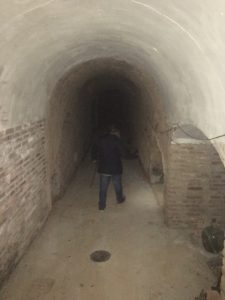 The front part of the building is split into two stories. On the ground floor there are a couple dozen barrels of wine and sundry bottles lying in piles on the dirt floor. In addition to Raúl’s own wines, I spot labels from Romanée Conti, Dujac, Selosse and Grünhaus, to name a few. Upstairs, there is a kitchenette and a basic bedroom setup. I ask Raúl if he ever sleeps here. “I have once or twice, but it’s more the young guys who help me out. Some of them bring their girlfriends here from time to time.” A remote farmhouse visited by tipsy young lovers in the dead of night? Décor featuring cobweb-covered chandeliers and derelict machine skeletons? Eli Roth, I think I have your next movie.
The front part of the building is split into two stories. On the ground floor there are a couple dozen barrels of wine and sundry bottles lying in piles on the dirt floor. In addition to Raúl’s own wines, I spot labels from Romanée Conti, Dujac, Selosse and Grünhaus, to name a few. Upstairs, there is a kitchenette and a basic bedroom setup. I ask Raúl if he ever sleeps here. “I have once or twice, but it’s more the young guys who help me out. Some of them bring their girlfriends here from time to time.” A remote farmhouse visited by tipsy young lovers in the dead of night? Décor featuring cobweb-covered chandeliers and derelict machine skeletons? Eli Roth, I think I have your next movie.
“The idea here is to beat the heck out of the wines,” Raúl says, as he hands me a glass of ruby-hued, extravagantly-perfumed Prieto Picudo. “We can then figure out what they can take and what they can’t. New wood, old wood; sulfur, no sulfur; stems, no stems – whatever doesn’t ruin them or render them completely uninteresting can be something to keep in mind for the future.” Most of the ensayos – “experiments” – in this bodega will never be commercialized. Some may not even be bottled. But all of them will contribute to Raúl’s understanding of this difficult variety and provide the framework for future vintages.
We move on through the high-ceilinged grape reception room into a deep cave lined with old cement deposits. The electricity isn’t working so Raúl lights the way with his phone. In a small alcove about 20 meters into the tunnel, we find two barrels of what I consider to be Raúl’s most challenging wine: Rara Avis. This is a 100% Albarín (not to be confused with Albariño) that, in vintages where all goes according to plan, spends a lengthy period of time aging under flor. What we taste here is the 2013 vintage, which will not be released until 2018, if it’s released at all. It has a flinty, Chenin-like quality along with some sweet corn and nut elements that emerge from the semi-oxidative aging process. A rare bird indeed.
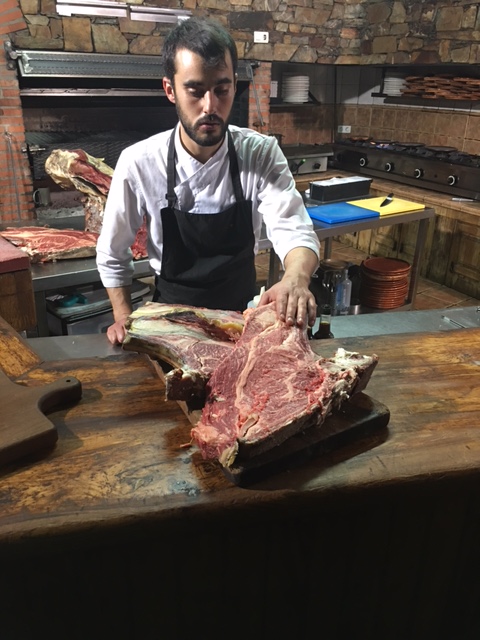 Dinner is at Bodega El Capricho, a restaurant attached to a livestock farm in the tiny village of Jiménez de Jamuz, about 70 kilometers southwest of León. The specialty here is steak, but you won’t find any black angus. What you will find in portions bordering on the obscene is buey, the meat of Rubia Gallega oxen raised on the property for as many as fifteen years before slaughter. We have three courses: Cecina (cured meat similar to Bresaola), tartare and a massive chuletón. Raúl inquires about the age of the beast whose meat we’ve just consumed. “This guy was just over six,” says the owner as he sits down with us and helps himself to a glass of wine. “Ah,” Raúl says, “I thought he tasted a little young.”
Dinner is at Bodega El Capricho, a restaurant attached to a livestock farm in the tiny village of Jiménez de Jamuz, about 70 kilometers southwest of León. The specialty here is steak, but you won’t find any black angus. What you will find in portions bordering on the obscene is buey, the meat of Rubia Gallega oxen raised on the property for as many as fifteen years before slaughter. We have three courses: Cecina (cured meat similar to Bresaola), tartare and a massive chuletón. Raúl inquires about the age of the beast whose meat we’ve just consumed. “This guy was just over six,” says the owner as he sits down with us and helps himself to a glass of wine. “Ah,” Raúl says, “I thought he tasted a little young.”
• • • • •
It is tempting to turn Raúl into a wine world archetype: the quixotic genius with eyebrow-raising personal grooming habits whose aw-shucks demeanor stands at diametric odds with the élite position of his wines in the market. Raúl doesn’t speak English – not can’t; doesn’t – so his story is mostly told through interlocutors, a situation in which, despite the best intentions of all involved, more lines of copy are devoted to the persona than the person. But perhaps the two are simply different poles of a spectrum. Maybe you can’t talk about the introspective, serious-minded winemaker without mentioning The Beard. Maybe it’s easier to explain his uncanny ability to parse the future character of wines that are totally sideways with fermentation aromas and wood shock if you note the fact that the dude actually believes he’s allergic to water. Maybe there is a useful winemaking metaphor to be found in his decidedly broad interpretation of the rules of the road.
• • • • •
A lucky mix-up at the rental car office in Santiago de Compostela the day before led to my leaving the lot in a BMW M135 rather than the Volkswagen Polo that I had reserved. This would prove crucial to my efforts to keep pace as I followed Raúl through the northwest of Spain. On the two-lane national routes, his average speed hovers around 190 km/h and his preferred lane seems to be “both”. There is one stretch where I’m sure I see neither brake lights nor a turn signal for over thirty minutes.
Wine has been produced here for thousands of years – indeed, many of the stone terraces that make viticulture here possible date back to Roman times – but the region is only beginning to achieve recognition on the international stage.
It is with some relief then that we finally pull to the side of the road in a small village in the Ribeira Sacra to meet with Pedro Rodríguez of Adegas Guímaro. Though Raúl only bottles a few references under his name in the appellation, he is perhaps the person most responsible for the modest success the wines are currently enjoying. Wine has been produced here for thousands of years – indeed, many of the stone terraces that make viticulture here possible date back to Roman times – but the region is only beginning to achieve recognition on the international stage. Arguably the two most prominent wineries in the American market are Adega Algueira and Adegas Guímaro. And who was the winemaker who lent his notoriety and expertise to these fledgling wineries, teaching them how to translate their magnificent terroirs into equally magnificent wines? None other than Raúl Pérez.
As Raúl naps in his car, I have a brief but very illuminating visit with Pedro during which I barrel-taste some tremendous 2015s, two of which will be bottled as Raúl’s most coveted red wines: El Pecado (“The Sin”) and La Penitencia (“The Penance”). I also learn an interesting “secret” about these two wines that prompts a funny discussion about points, prices and the vagaries of the vinous-industrial complex. You can ask me about it sometime if you want to become even more cynical about the way that absolute values are ascribed to wines in this day and age. We wake up Raúl and head out to another bodega where he matures the wines for his new label, Castro Candaz, a partnership with Rodri Méndez.

While El Pecado and La Penintencia are produced from fruit grown in the Amandi zone of the Ribeira Sacra, the fruit for A Boca do Demo and Finca El Curvado from Castro Candaz is from the Chantada zone. The Amandi zone is warmer by comparison, with slate-based soils. In Chantada, the Sil River widens, the slopes become less steep and the soils feature more granite than slate. “If we were going to try to make wines here like El Pecado and La Penitencia,” Raúl explains, “we would harvest later due to the lower temperatures. But the idea of this project is to keep the wines at 13% alcohol or less, so we actually harvest earlier than we do in Amandi.”
The bodega is another “fake-it-until-you-make-it” facility. “The guy who owns it refuses to sell it to me,” Raúl says. “But he also doesn’t charge me rent. It’s very curious.” There is no de-stemmer here, nor would the meager electricity be sufficient to power one, so the fermentations proceed with 100% whole clusters. The “village wine”, Finca El Curvado, is produced from three sites with an average vine-age of 40-50 years. There is Mencía, to be sure, but also significant amounts of Alicante Bouschet and Domingo Pérez (one of the dizzying array of names used here for Trousseau). There is a 30-day maceration followed by fermentation in 1500L foudre and aging in smaller French barrels of varying size and age. The top wine, A Boca do Demo, is from a single vineyard of 70-80 year-old vines with a similar varietal breakdown and élevage.
It’s a bit complicated with the Gallegos. There’s a certain code here that can be very hard for outsiders to understand. They have their own way of thinking, talking, doing business. I was born 30 kilometers from the border, but I might as well be from a different planet.”
The wines on their way to the US are from 2014, the third consecutive cooler- and wetter-than-average vintage in the region. Despite the challenges of the vintage, diligent farming brought in healthy fruit with great freshness and verve. Lots of folks I’ve encountered in the trade seem to suffer from a kind of varietal synesthesia that causes them to taste Pinot Noir-like character where none is present. I’ve seen this to a maddening degree with Mencía-based wines. Cabernet Franc? I’m with you. Syrah? Sure. But Pinot? I failed to see it until I tasted these ‘14s. There is a distinct Côte de Nuits element to them that is rather astonishing and definitely delicious.
I ask after the white wine, a Godello-based bottling called El Vertical that I’ve heard rumors about. “Yeah, we don’t have that this year,” says Raúl with a rueful shake of his head. He explains that the guy who sells him the fruit for this project had agreed in principle to deliver the grapes at harvest time only to pull out at the last minute. “I think that maybe he messed up and left the grapes on the vine too long and he was too embarrassed to say so. It’s a bit complicated with the Gallegos. There’s a certain code here that can be very hard for outsiders to understand. They have their own way of thinking, talking, doing business. I was born 30 kilometers from the border, but I might as well be from a different planet.”
• • • • •
Is Raúl Pérez the best winemaker in the world? He was awarded that honor by Bettane+Desseauve in 2015 and Der Feinschmecker in 2014, but I think such accolades often say more about the people or organizations bestowing them than they do about the recipients themselves. Raúl would certainly not self-apply the title. Superlatives like “best” carry with them an attitude of finality. The journey Raúl is on, however, has no fixed destination; the mountain he’s climbing, no summit. Regardless of their chosen medium, the artists who leave the most enduring legacies are those who never stop pushing the limits, who never trade restlessness for comfort or complacency. The future is the province of the bold, and Raúl is headed there with the pedal on the floor.




